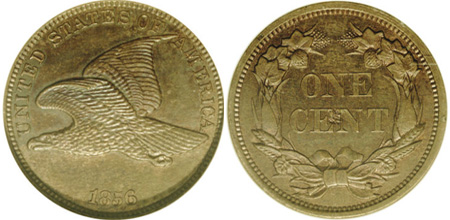Background and History
The 1856 Flying Eagle Cent (Buy on eBay) is technically a pattern piece, which was created in considerable numbers to illustrate the concept of a small sized cent. Until that point, the one cent coin had been a bulky pure copper piece, nearly as large as the half dollar. By the 1850’s the cost of producing the large cents had become greater than the face value. Also, the coins were increasingly unpopular with the public due to their weight and lack of legal tender status. Some banks and stores refused them, while others only accepted them at a discount.

The new one cent coins would have a different composition, weight, and design. A number of alloys including copper, nickel, and zinc were initially examined before the Mint Director approved an alloy of 88% copper and 12% nickel with a weight of 72 grains. The new coins were designed by James B. Longacre. The obverse features an eagle in flight that closely resembles Christian Gobrecht’s design for the reverse of the Gobrecht Dollars issued from 1836 to 1839. The reverse features an agricultural wreath of corn, wheat, cotton, and tobacco similar to the one designed by Longacre for the three-dollar gold piece.
Near the end of 1856, the Mint produced several hundred of the new small cents for distribution to Congressman, Treasury officials, and other important figures to gain support for the new design and format. The efforts were successful, and the new small cent was authorized with the passage of the Mint Act of February 21, 1857. The Flying Eagle Cent was produced for circulation starting in 1857.
The 1856 Flying Eagle Cents were immediately popular with collectors. Some collectors were fortunate enough to acquire pieces from the original limited distribution, but there was demand for far more. Over the next few years, the Mint would restrike and sell to collectors hundreds more 1856-dated cents. These coins can be found with either uncirculated or proof finishes, although debate continues as to whether all strikes should be considered proofs.
Coin Mintage
The total estimated mintage across original coins and restrikes ranges from a low of 1,500 to as many as 3,000 pieces. This is considerably higher than the typical production level for a pattern piece. Most patterns are made in small numbers for in-house evaluation, but in this situation the patterns were produced in larger quantity to ensure the passage of the authorizing legislation. The restrikes made in later years were produced for distribution to interested collectors.
Despite the fact that the 1856 Flying Eagle Cent has one of the highest mintages for a pattern coin, most collectors view the coin as a rarity and consider it to be part of a complete set of Flying Eagle Cents. This perception of rarity and the continued popularity of the issue contribute to high prices even for well-worn examples.
Finest Known and Values
The finest known 1856 Flying Eagle Cent is an example graded PCGS PR-67+ from the Simpson collection. This coin is of the Snow-3 variety, which was believed to be the first die pair used to strike the issue for the initial distribution to Congressmen and decision makers. This well preserved and historically important example realized a record-breaking price of $240,000 when it was sold at auction in September 2020.
Other top graded examples include one coin each graded PR-67 by PCGS and NGC. This is followed by a handful of coins graded either MS-66 or PR-66 by each service. The identification as proof or mint state has varied over the years and typically depended on the quality of the surfaces and completeness of the strike until more information was known about the different die varieties. In recent years, examples graded PR-66 have sold for prices ranging from around $40,000 to a high of $88,125.
At the lowest end of the spectrum, there are examples of the 1856 Flying Eagle Cent that circulated heavily or were improperly cleaned. These examples can typically be purchased for less than $10,000.

